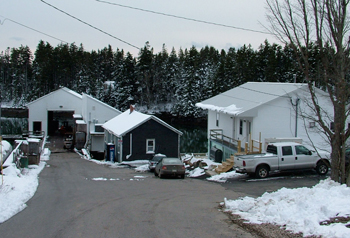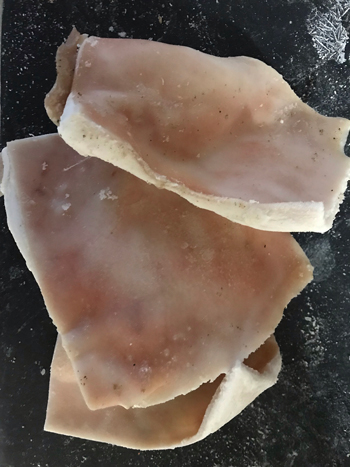Alternative Bait Protocols To Be Developed
Continued from February 2019 Homepage

Winter Harbor Coop. The shift to alternative baits could cut into profit margins at coops. Herring bait will likely have to be supplemented with unfamiliar fish and alternative bait. There could be a regulatory and pricing learning curve that goes with the shift. Fishermen’s Voice photo.
Development of the resolution was the focus of the Jan. 4 webinar. The questions considered by the working group included:
• Do any other states, in addition to Maine, have restrictions on bait?
• Should the resolution prohibit “bad” species or promote “good” species?
• What is the problem statement or evidence that supports the need for a resolution?
• Maine has a list of approved and prohibited bait species. Is that list appropriate for the entire lobster management area?
According to the DMR, a number of marine species have been reviewed by agency for use as bait in the lobster and crab fisheries. It’s illegal to use for bait any organisms that are on the DMR’s “prohibited” list or that haven’t been reviewed by the DMR. Bait dealers may be granted an exemption that allows them to sell a “prohibited” bait if they agree to follow specific procedures that the DMR considers sufficient to remediate the risks of introduction (e.g. establishing a chain of custody, pre-importation testing, processing). Individuals may apply for review of non-listed bait sources, or petition for use of a prohibited bait source, by completing the DMR’s “Lobster and Crab Bait Review Form.”
Some approved baits, in addition to Atlantic herring, include, for example any species in the Gulf of Maine and Georges Bank groundfish complex, Atlantic cod, croaker and Atlantic and Pacific ocean halibut.
It’s illegal to use for
bait any organisms
that are on the DMR’s
“prohibited” list.
There are organisms like orange roughy from Australia and New Zealand. Mackerel may be used from the East Coast, Japan or Portugal, but if it’s from China it must be frozen.
Examples of prohibited bait species include hake form the U.S. West Coast, because of the exotic pathogens; and horseshoe crab from Asia, because of the possibility of invasives.
DMR Resource Coordinator Nicholas Popoff said the agency was recently petitioned to allow the use of salmon racks from land-based aquaculture facilities.
“We’re evaluating that now,” he said. The use of racks from wild-caught salmon or ocean-based salmon farms has been prohibited, he said, due to the potential for pathogens.
Maine’s development of the lists was triggered in recent years, he said, because of concern about a variety of baits coming into the lobster fishery from different sources. Maine’s protocol includes chain-of-custody documentation that’s included with every container of bait coming from outside the state, plus the right to inspect such containers, he said.
“It should be a bait that’s on our approved list,” he said. “If it’s not, it’s flagged.”

Pig hide bait, relatively new among hide baits, has been popular in Maine in the last few years. The product has been refined and has been approved by the Maine DMR for use as lobster bait. Photo courtesy of 1st Rate Bait Co.
A species that’s neither on the approved nor the prohibited list must go through a review, he said. He noted that the state, early on in the process of developing its list, contracted with a bioscience lab to conduct testing for some specific diseases in some species. Other than that, much of the certification process is based on bioscience literature, he said.
“We in the state of Maine haven’t done disease testing,” he said. “If it gets to the point where we need testing, we’ll figure that out.”
Working group member Jeff Shields, a disease specialist, wanted to know if fishermen are honest about reporting what species they’re using as bait. Although certification is required, its workability depends on how rigorous the process is, he said. He noted that an organization called World Animal Health has a process in place, with rigorous standards, for the transfer of organisms across international boundaries. Research into that process might be useful, he said.
“When I see certifications, I start to think that can get pretty complicated pretty fast,” Shields said.
Shields noted the discussion is not only about the type of disease that might affect lobster, but about the larger issue around viruses and bacteria, brought to the Gulf of Maine from outside bait sources, that could potentially have deleterious effects on native species in general.
“Another aspect of
the problem is the
potential for countries
that import Gulf of
Maine lobster to shut
down importation if
there are certain a
reportable diseases
in the gulf”.
– Nicholas Popoff,
Maine DMR
Resource Coordinator
“Given the scale of how much bait is used, that’s highly relevant,” Shields said. “It’s not the lobster health issue, really. It’s other species.”
Popoff noted another aspect of the problem is the potential for countries that import Gulf of Maine lobster to shut down importation if there are certain a reportable diseases in the gulf.
Working group members said it would be useful to canvas fishermen and dealers to find out more about what baits are being used; and to ask processing plants if they’re seeing any new species to be used as bait on the horizon.
Popoff said the state has begun talks with the industry about potential alternative baits, like redfish and Asian carp. In response to the reduction of the herring quota, many are looking toward using more menhaden as bait.
According to the DMR, lobster and crab fishermen have historically fished using Atlantic herring and menhaden as bait, but quotas for these species have been reduced significantly in the last decade, causing price increases and reduced availability.
“In response, industry sought non-historic bait sources that are less expensive and more readily available,” the DMR said. “The ecological risk of these non-historic baits was previously unknown. The new classification system and review process were created to prevent the introduction of diseases and pest into Maine’s coastal waters.”
